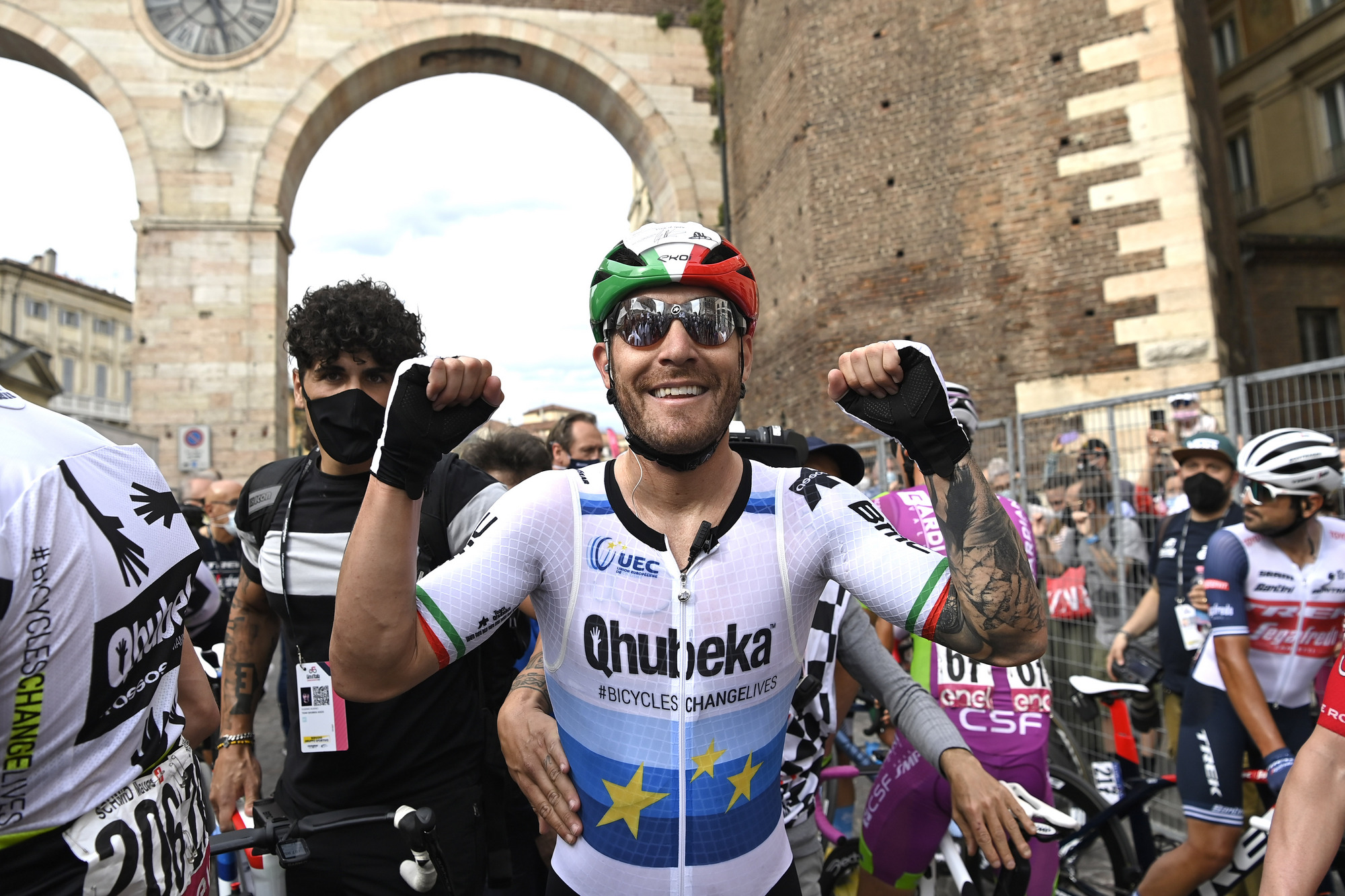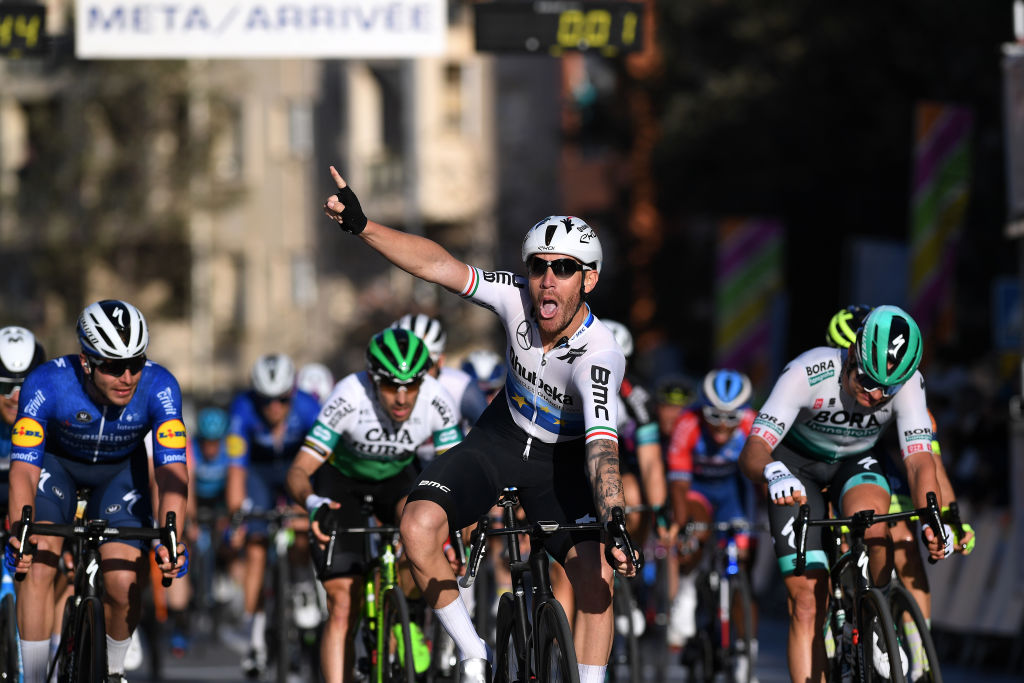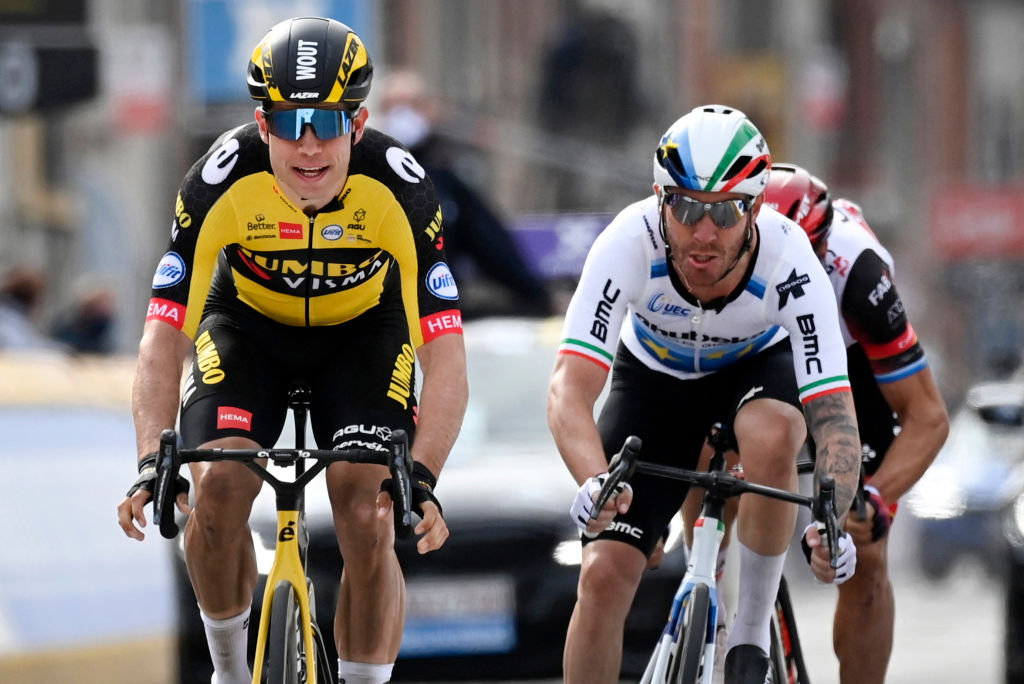Giacomo Nizzolo: Making up for lost time
Procycling magazine interviews the European and Italian champion

After enduring a torrid period blighted by injuries, Giacomo Nizzolo was back
to his best in 2020, winning the European and Italian Championships. The sprinter tells Procycling magazine about rebuilding his form and his aim of finally winning a stage at the Giro.
This article was taken from Procycling magazine issue 281, May 2021.
Injuries are considered part of being a professional cyclist. For a start, crashes come with the territory of road racing, and that’s before accounting for cycling being so physically demanding that eventually it will take a toll on the body in various ways. But what happens when the injury isn’t a broken bone, or something with a quantifiable recovery timeline? What if it’s an injury that’s debilitating, chronic and endures for years and years?
Between the 2017 and 2018 seasons, Giacomo Nizzolo spent almost as much time on the sidelines as he did performing his job as a bike rider. Then aged 27, he should have been hitting the best years of his career. He’d just enjoyed his most successful season in 2016, winning seven races, including the Italian national road title, but then he began to feel pain in his knee. At first, he hoped the problem was temporary. He’d been due to start his 2017 season in Argentina in January, so he’d miss a few weeks at worst, and once he had a bit of treatment he’d surely be back.
In reality, the pain was being caused by tendonitis and it was over four months before he pinned on a number that year, at the Tour of Croatia in mid-April. Even then, every race he started was followed by a period off. He abandoned the Giro d’Italia after 10 days. He didn’t finish the National Championships or Clásica San Sebastián. He didn’t race between July and mid-October, after which he was deployed to the season-ending Tour of Guangxi, to get some race kilometres in his legs. All in all, he clocked up just 26 race days that season and not a single individual win.
Nizzolo looked like he’d turned a corner at the start of 2018, winning a stage at the Vuelta San Juan in January before picking up a couple of top fives at the Tours of Oman and Dubai. Finally, he could start again.
Get The Leadout Newsletter
The latest race content, interviews, features, reviews and expert buying guides, direct to your inbox!
Yet his knee issues quickly flared up again. He abandoned Tirreno-Adriatico and missed that spring’s Milan-San Remo. Another DNF at the Tour of Croatia ended his hopes of riding the Giro d’Italia. There was another DNF at the Tour of Poland in August and even after gaining some consistency by completing the Vuelta a España, he crashed out of the Tour de l’Eurométropole with a fractured hip. It was a constant two steps forward, one step back.
“Mentally it’s tough, because with these problems you never know when it will end. Sometimes you think it’s never going to finish. It’s not easy, because you have one or two weeks where you start to feel better, and then you stop again. Basically in those two and a half years I never had more than three weeks’ consecutive training. Every third week I had to stop, so you can imagine that it was not easy to make a programme, to get in shape and to perform,” Nizzolo tells Procycling.
“There was never a day where I said, ‘Okay, this is over now.’ But there were tough times, tough months and it was a tough year in general because it was not easy to see the light at the end of the tunnel, you know what I mean? As I said, two weeks would go better and then the third week it was getting worse so I said, what is going on here? It’s never ending.”
The turning point finally came in 2019, when Nizzolo had knee surgery. Today, remarkably, he says he feels no effects from the injury, despite it causing so much trouble for so long.
While the surgery was the fix he’d been looking for, and the pain had gone, the Italian had another challenge: to try and get back to his old level. It wasn’t easy. In 2016, Nizzolo felt like he was on the point of reaching his peak.
“I felt then that I had just the final step to go to get the best potential out of myself. And I couldn’t do it. I felt like I was just there, I missed just a bit, and then I went backwards,” Nizzolo says. “Then to restart from there was a long way. Personally, I couldn’t fix it in several months. I had to spend a lot more time to get back to this level and then to the best form.”

The loss of almost two years of quality racing was clear to see during Nizzolo’s 2019 season, and the year was punctuated with 12 race abandonments as he struggled to build up his endurance. The only stage race Nizzolo completed was February’s Tour of Oman. Still, the season did bring three wins, so the trajectory was at least very clearly ticking upwards in the right direction. Despite the abandons, most importantly, when Nizzolo was racing, his level and performances were better than the year before.
Then finally, by the start of last year, the pieces were gradually clicking into place. Nizzolo won the stage 5 sprint at the Tour Down Under ahead of riders such as Sam Bennett and Caleb Ewan. It was his first WorldTour level victory since 2012. A few weeks later he won the second stage of Paris-Nice. More wins were still to come, on the other side of the covid-19 enforced break, at the Italian National Championships and then a maiden European Championships title, his season’s high point. Elsewhere there were runner-up spots at Race Torquay, Kuurne-Brussels-Kuurne and Circuito de Getxo, and a further 10 top-10 placings. It was his best season for many years, with consistent good results.
“Every time I was in the race I felt I could be competitive, I could play for a good result. That was what I was missing in the three years when I had the problems, injuries with my knee,” he says.
The real turning point came, however, at Milan-San Remo last August where Nizzolo finished fifth. The classic holds a special place in the heart of the Milanese, as a home race but also one most suited to his characteristics. It’s long been a target. In the sprint for third place behind winner Wout van Aert and Julian Alaphilippe, Nizzolo finished alongside Michael Matthews and Peter Sagan for his highest ever finish.
“It was that kind of momentum that I got. Basically after San Remo I could really feel that I was in really good shape. Then I pulled out the National Championships and the European road Championships,” he says.
“To win the Italian National Championships was like, okay, I’m back. I’m back from where I left off. And then after that victory, it gave me a lot of confidence and a lot of happiness. I went to the European Championships and I was kind of still full of adrenaline and, you know, when you are in this kind of daze, where everything goes well - I was in that mood. The first stage of the Tour I thought I could continue the streak, but then it didn’t happen.”
Another factor that’s had a major impact on Nizzolo’s comeback was his decision to switch teams in 2019 to Qhubeka-Assos. The decision wasn’t taken lightly; the now 32-year-old had been in the same team his whole career, having joined Trek-Segafredo when he turned pro.
“After such hard years in 2017 and 18 I felt I needed a different environment. Also to find new challenges, new motivations. I had definitely no problem where I was, I am still in great contact and nice contact with them but I spoke with them straightforwardly. I needed new motivation, new challenges, new people around me and I think it was the right moment to do it and definitely after two hard years it was also another kick that helped me to get back, to have new people around,” Nizzolo says.
“It was definitely a big step for me. I never changed teams before that, so it was a new adventure. But I felt immediately comfortable in the new team and I had nice support from them, and I enjoyed it, definitely, from day one. It was pretty easy, easier than I thought, to be honest.”

At Qhubeka, Nizzolo is the team’s leader for the sprints and classics. It’s a privilege that allowed him to know sooner than others last year that the team was going to continue into 2021, after sponsorship woes threatened to pull the plug entirely.
The South African squad has internationalised over recent years, and along with Domenico Pozzovivo and Fabio Aru, Nizzolo is one of four Italians there this year. Still, he’s rare in being one of the few top Italian riders who have never ridden for an Italian team, or one with an Italian influence.
“I’m Italian but I’ve never been in an Italian team. Of course my culture is from Italy but I don’t miss the feeling of being surrounded by Italians because I was always in international teams,” he says. “I feel absolutely natural in this team and I think it’s a great thing to have many nationalities in the team.”
The classics and sprints might be Nizzolo’s forte, but he’s the type of rider who falls in that grey area between the two. He’s not a pure power sprinter, suited to a fast, flat finish. He’s also not a complete classics rider, when compared to the likes of Wout van Aert or Mathieu Van der Poel, as he can’t match them on the climbs. According to his own description, Nizzolo needs “a harder race” to achieve his goals. “That’s basically how I see myself right now in the bunch. And also in terms of endurance, I maybe need long days, long stages.”
Looking through his wins, you can see the type of conditions in which Nizzolo clearly thrives: tough, attritional, rolling parcours. His fifth place at San Remo came at the end of the longest-ever edition of the race at 305km and in the peak of August’s heat. His Paris-Nice stage win last year came at the end of a day where the peloton was blasted with crosswinds. He won the European Championships in Plouay, France, on a similar lumpy circuit to the GP Plouay ahead of riders such as Arnaud Démare - then enjoying his own purple patch - and Van der Poel. Even looking back to 2016, he won Gran Piemonte, which features a dragging uphill sprint.
“I’ve got more experience but the way I race hasn’t changed too much. That’s my approach, it’s always been like this,” he says.
“I try to gamble, obviously, a little bit as a sprinter. I cannot spend too much, but I try to invest when it’s necessary and that’s the way I like to race in the classics especially.”
After the classics campaign, the big target is the Giro d’Italia. Nizzolo has never won a grand tour stage, even though his record in his home grand tour is staggeringly consistent. He’s twice won the points classification, and has finished in the top five of a stage on 25 occasions - 19 per cent of all the race days he’s contested there. He’s finished second nine times. He even crossed the line first on stage 21 of the 2016 race, only to have the victory taken away by the commissaires for what they believed was dangerous riding.
“For me to wear that jersey of European champion and Italian champion on the roads of Italy, I’m proud. And I’m ready to try to get a stage victory in Italy with that jersey,” he says.
“I’ve had many, many second places and I’ve twice won the points jersey without winning a stage so I think it’s time to do it.”
Listening to Nizzolo, you get the sense he tries to see the positive in the tough situations he’s endured. He believes coming through a period as difficult as the 2017 and 2018 seasons taught him what he’s capable of dealing with, and left him proud of his mentality to push through and come back. He ranks his best days on the bike in terms of his performance, rather than the result. It’s why last year’s fifth in San Remo is something he looks at more fondly than some wins.

He even looks at his string of second places at the Giro with a glass-half-full view. “When I was always second they asked me, how can you win? How can you use that, and in the end I say, okay, I can do my best, if the best of the day is second place. There was a day where I could win and I didn’t because of some mistakes. But in the end, second is better than third,” he laughs. “So if second is coming I’ll take it.”
The signs are all there that Nizzolo’s wins in 2020 were not an anomaly, but rather a sign of a rider back where he wants to be. He started 2021 with a victory at Clásica de Almería, was fourth at Brugge-De Panne was second to Van Aert in Gent-Wevelgem. Ultimately, though, having worked his way back to a racing level he once thought he’d lost, Nizzolo just wants to make the most of the opportunities that come his way from now.
“I have a feeling I left a lot on the road because of the injuries, and I would like to take the chances as much as I can to take back what I lost,” he says. “It’s not easy, because the level is always higher, but I definitely feel younger than I am because of that.”
Procycling magazine: the best writing and photography from inside the world's toughest sport. Pick up your copy now in all good newsagents and supermarkets, or get a Procycling subscription.
Sophie Hurcom is Procycling’s deputy editor. She joined the magazine in 2017, after working at Cycling Weekly where she started on work experience before becoming a sub editor, and then news and features writer. Prior to that, she graduated from City University London with a Masters degree in magazine journalism. Sophie has since reported from races all over the world, including multiple Tours de France, where she was thrown in at the deep end by making her race debut in 2014 on the stage that Chris Froome crashed out on the Roubaix cobbles.